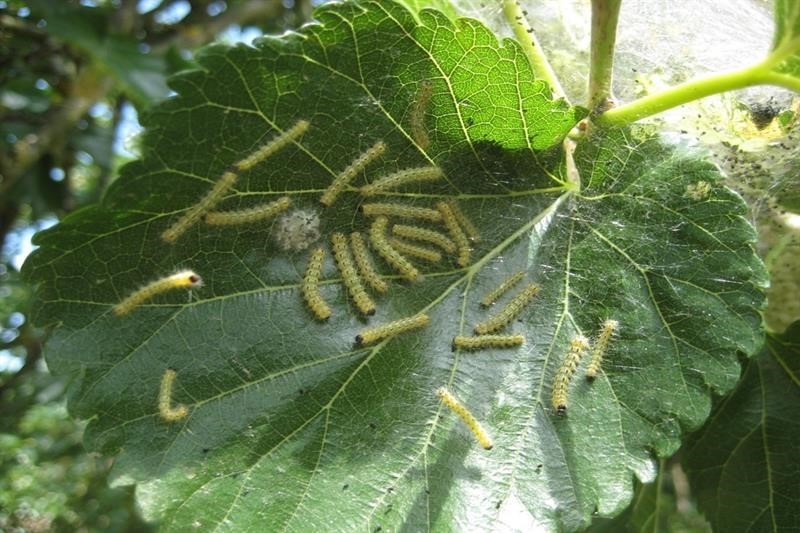It harms 628 different plant species
DÜZCE (İHA) – Esra Uzun, the Director of Agriculture and Forestry in Düzce, stated that chemical control methods should be preferred as a last resort in combating the American White Butterfly. The pest, which has been present in Düzce for many years and has adapted to the region…

DÜZCE (İHA) – Esra Uzun, the Director of Düzce Agriculture and Forestry Directorate, stated that chemical control applications should be preferred as a last resort in the fight against the Fall Armyworm.
The Harmful Fall Armyworm, which has been seen in Düzce for many years and has adapted to the region, generally starts to cause damage with its first generation in the third weeks of June. This pest, which has the ability to feed on many plants, can increase its population and cause new damages in different areas if not controlled. Academic studies have revealed that this pest causes damage in 628 different plant species, primarily seen in the region on mulberry, maple, and hazelnut trees, and also causes damage on other plants such as apple, pear, cherry, orchards, and even trees like poplar.
The main damage caused by the Fall Armyworm pest is done by the larvae called caterpillars hatching from eggs. This pest usually lays eggs under the leaves, rarely on the upper side of the leaf, and the caterpillars hatched from the egg clusters start feeding in groups on the leaves. During this period, the caterpillars living together continue their lives by forming a web layer on themselves. Each individual, after completing its feeding, starts to live individually and then disperses to enter the pupa stage, a resting or overwintering form, in order to form the adults of the next period, hiding in cracks in the soil, between the roofs of houses, or on tree trunks.
In the year 2024, the first butterfly sightings were observed at the beginning of June, but the butterfly sightings are gradual. Nowadays, especially in gardens, leaf inspections should be carried out to find the pest’s egg packets, especially on the upper branches. If eggs are found, depending on the temperature, these eggs will hatch in 1-3 days, and the young larvae hatched from the eggs will continue their lives by feeding together for about 10 days without separating.
“June and August are breeding times”
Esra Uzun, the Director of Düzce Agriculture and Forestry, said that in our region, with two breeding damages in June and August, it is time to start fighting against this pest as egg packets and larval clusters are seen on leaves during the controls conducted. Due to the non-simultaneous emergence, Uzun stated that producers should constantly check their gardens, and if the pest surpasses the economic damage threshold, they should start control measures.
“Chemical control as a last resort”
Stating that ‘Integrated Pest Management Principles containing alternative controls should be prioritized in the fight’, Director Esra Uzun said, ‘If necessary, Chemical Control applications should be preferred as a last resort. In order to determine the emergence and population density of the butterfly, decisions on control should be made by determining the emergence and density of adult butterflies with Pheromone and Light traps. If 5 caterpillar colonies are detected at the beginning of the year in Hazelnut fields, a decision should be made to control. If control is necessary, different control methods can be used together, giving priority to methods with minimal environmental damage. Initially, mechanical control, biological control, and physical methods are applied. If the applications are not sufficient, environmentally friendly pesticides are used. When selecting pesticides, chemicals that are least harmful to the environment and natural enemies are chosen and applied. It is of great importance in Cultural Control to collect and destroy egg clusters from trees and cutting off caterpillar colonies on long branches with telescopic shears, thus protecting both the environment and human health without the need for any chemicals. In addition, hanging cardboard, cardboard, or jute sacks on tree trunks will help to catch the insects in a mass.’
“Reducing economic damage”
Pointing out that the main aim of the fight is not to completely eradicate the pest but to keep the damage caused by the pest below the economic damage threshold by considering the population density, Esra Uzun said, ‘The pesticides purchased from the Düzce Provincial Administration budget will be distributed to the neighborhoods where the pest is densely seen. With the distributed pesticides, common areas of villages, roadsides, and pastures will be sprayed. In the controls that farmers will conduct in their own gardens, when egg packets, larval clusters, and woven webs are encountered on the leaves, these should be destroyed by cutting with pruning shears, and in case of high population, a decision for chemical control should be made. It is important in chemical control not to harm bees, therefore, it is crucial that the pesticides distributed to neighborhoods are used first, and if they are not sufficient, farmers should apply to the Provincial or District Directorates to get a prescription, then acquire the prescribed medicine and start chemical control.’
Esra Uzun concluded by saying, ‘Ten to fifteen days after chemical control, trees should be checked for new infestations or new egg packets, and if found, a second chemical control should be carried out. Since collective control is important in the fight, joint control in areas where the pest is dense will reduce the pest density. Our producers should be careful; as it is currently mid-season for hazelnuts in our province, they should allocate time for the fight; otherwise, the insects feeding on the leaves of the plants can significantly affect the yield negatively.’






